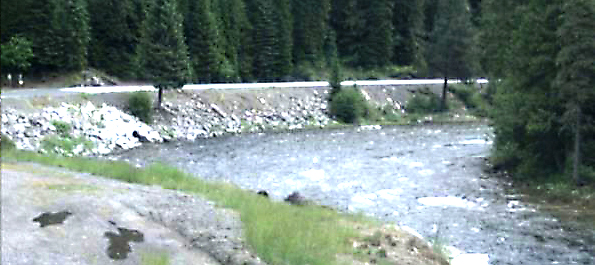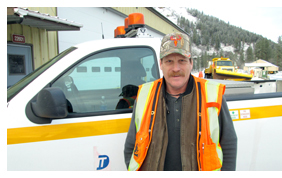

Ice bath: Kooskia’s Graves involved in frigid Lochsa River rescue
Often, it boils down to being in the right place at the right time. Luck? Maybe. Serendipity? Possibly. Good fortune? Definitely.
Dana Graves, a worker in the Idaho Transportation Department Kooskia Maintenance shed since March 2007, was on a stretch of two-lane U.S. 12 near Kooskia and the Idaho County border in the late afternoon of Nov. 25, no doubt already contemplating the Thanksgiving feast to come two days later. The day had begun with somewhat routine rock patrols and vehicle rescues on the highway, including plowing slush from the earlier snowfall now melting in the area’s rain.
 Around that same time, a white Chevy Tahoe eastbound on U.S. 12 was being driven by Branden Spellmeyer, carrying Deborah Lee and Katherine Ottawa. As Spellmeyer rounded one of the many curves in this section of 50-mph roadway, about 20 miles on the Idaho side of the Montana State Line, the Tahoe began to slip from his control. As he lost control of the vehicle, it rotated clockwise, running off the right shoulder of the road.
Around that same time, a white Chevy Tahoe eastbound on U.S. 12 was being driven by Branden Spellmeyer, carrying Deborah Lee and Katherine Ottawa. As Spellmeyer rounded one of the many curves in this section of 50-mph roadway, about 20 miles on the Idaho side of the Montana State Line, the Tahoe began to slip from his control. As he lost control of the vehicle, it rotated clockwise, running off the right shoulder of the road.
The Tahoe slid down the embankment, rolled, and landed upside-down in the Lochsa River, victim to the cloudy and snowy conditions, the dark of the oncoming night, heavy snowfall and slushy highway conditions.
Graves came around a bend in the road just a few minutes later and sprang into action. The Tahoe’s cab had crumpled on a large boulder, with the rear end pointed skyward, the front shoved down in the water, and the back pointed upriver.
“A motorist waved me down to inform me of a vehicle in the river. There were headlights in the water and taillights pointing up in the air,” Graves recounted. This was about 5:35 p.m.
Aware that his actions had to be quick and decisive, he started by parking the snowplow he was driving in a turnout, so that its lights shone in the direction of the capsized vehicle. Several other motorists had stopped as well, and Graves arranged those vehicles to also light the path.
Graves then set flares, and walked downriver toward the car to assess the injuries. Thankfully, the one occupant still trapped in the vehicle, Lee, reported only minor head injuries. Graves returned to his snowplow to call State Communications to report the incident.
“I also knew an Idaho State Police crew who had been dispatched to help out a disabled Freightliner rig and would be on the way toward me,“ Graves said.
Knowing he did not have the luxury of time, Graves ditched the running shoes he had been wearing and put on boots to insulate him against the frigid waters. Graves donned a pair of spiked work boots he had in his ITD vehicle.
The spikes on the boots provided just enough traction on the slick and steep embankment for Graves to walk to the river’s edge. A young married couple from Lapwai, who had been trying unsuccessfully to free Lee, informed Graves that the wife lacked the strength to pull her out, and the husband was too big to maneuver through the small opening.
 The young wife from Lapwai was instrumental, though, as she had moved Lee’s head and face out of the icy water.
The young wife from Lapwai was instrumental, though, as she had moved Lee’s head and face out of the icy water.
But now there was another problem – Graves’ gear was getting in the way.
He returned to the shore, removed his baseball cap, glasses, radio, reflective vest and his own personal vest to eliminate the entanglements, then waded back out to the vehicle in the river to see what could be done to free the woman trapped inside.
“The water was over the top of my boots, and went to just below my knees,” said Graves.
Lee was halfway in and halfway out of the water. Removing her from the vehicle would be challenging because the cab had been crushed inward, creating a big hump she would have to be pulled over. The crushed top also stopped the seat from sliding back to give her more room.
“On top of that, the ice in the river had been breaking loose the last few days, making it even more serious,” Graves explained. With the ice melt, the river was running high and cold. The woman reported having no feeling from the waist down. Any rescue attempt had to avoid her left arm, too; Lee warned them it could come out of the socket. Graves figured it was from a previous injury.
Lee yelped as he pulled — her knees and feet were caught up in some of the twisted metal. After repositioning her legs, Graves pulled on the heavy leather belt Lee had around her waist. With considerable effort, she was inched to the apex of the hump, but was stuck on the plastic lid of the compartment until Graves ripped it off and moved it out of the way. With the help of the man from Lapwai, Lee was finally pulled through the driver’s window and to her feet.
“We then coaxed her into walking as we held her up by her belt and upper body,” Graves said. This served a dual purpose – after being in the water so long and being numbed, they needed to get the blood moving again in Lee’s legs and feet. Her walking also made it much easier to traverse the slippery rocks back to the shore.
Lee was almost to the bank when she collapsed. Graves told her she could get on his back and he would crawl up the bank, but she did not even have the strength to hold on around his neck. As Graves contemplated using Lee’s long winter coat as a sled to pull her up the snowy bank, the end of a tow strap appeared from the top of the embankment. Graves grabbed the tow strap and used it to anchor himself to the steep hillside while he pulled her, a foot at a time, up the incline.
 “The people on the end of the tow strap were very important to the success in getting her up to the highway,” Graves explained.
“The people on the end of the tow strap were very important to the success in getting her up to the highway,” Graves explained.
With Lee securely out of the river and up on the road, the focus moved to getting her warmed up. Graves grabbed her hands out of the snow to warm them, and a passer-by stopped with a bed already made up.
“People onsite moved her to the car, put her inside and cranked up the heater, piling clothes, blankets, sleeping bags and anything else that could offer warmth,” Graves recalled.
ISP then arrived on scene, and Missoula Ambulance was called to take Spellmeyer, Lee and Ottawa to St. Patrick’s Hospital, according to an Idaho State Police report of the incident. Spellmeyer was ultimately cited for driving too fast for conditions.
“To my regret, I do not know the names of the Lapwai couple, who should be recognized for their amazing efforts,” Graves said. “The number of people who helped in one way or another with this rescue, and the importance of the parts they played…my admiration for them is hard to put into words.”
Graves arrived at home in Kooskia at 8 p.m. His normal 10-hour shift had ended at 4:30 p.m. — and then he went into “extended service” on an unusual, but memorable day. According to the clock in his truck as he headed home, he had been in the water from 5:35 p.m. to 6:39 p.m. helping to extract Lee.
On a typical night it can be hours without a single car on that section of U.S. 12 – luckily for Lee and the occupants of an overturned white Tahoe in the Lochsa River, Nov. 25, 2014, was anything but typical.
“I don’t deserve all the credit,” Graves said. “The Lapwai couple — I wish I knew who they were so I could thank them properly — was instrumental. The people with the tow strap were critical. The folks who provided the sleeping bags and warm clothes for that woman were critical, too – it took us all.”
Pictured above: The section of U.S. 12 at milepost 155.5 where the river rescue occurred. Also pictured is Graves at work at ITD's Kooskia Maintenance shed.
Published 01-09-15